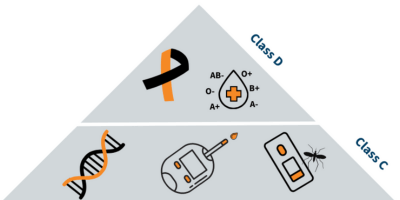The world of in vitro diagnostics is all about accuracy and reliability.
EU IVDR includes a requirement to write a
Summary of Safety and Performance (SSP) for Class C and D IVDs. The goal is to emphasise transparency and provide adequate public access to summarise the data on safety and performance to patients and intended users, which includes both professionals and lay people where applicable.
This blog post will unpack the Summary of Safety and Performance (SSP), explaining what it is, why it matters, and what it contains.
What is Summary of Safety and Performance (SSP)?
The Summary of Safety and Performance (SSP) provides key information about a medical device’s safety and effectiveness in an easy-to-understand format. This information is crucial for healthcare professionals and, in some cases, patients, to make informed decisions about using IVD devices.
The data presented in the Summary of Safety and Performance (SSP) is compiled directly from the technical documentation. Under EU IVDR, the SSP must be validated by a Notified Body (NB), updated annually with new information, and made publicly accessible via EUDAMED.
The SSP helps ensure transparency in the regulatory process by providing stakeholders with essential details about a device’s clinical performance, safety measures, and intended use. Manufacturers of IVD devices must ensure the SSP accurately reflects up-to-date evidence supporting the device’s compliance with EU IVDR requirements.
By maintaining a well-documented and validated SSP, manufacturers can demonstrate adherence to IVD regulations, build trust with healthcare providers, and support the safe and effective use of medical devices within the European market.
Why is Summary of Safety and Performance (SSP) important?
- The Summary of Safety and Performance (SSP) plays a crucial role in ensuring transparency and informed decision-making in the field of medical device testing. By making essential data on an IVD medical device’s performance publicly accessible, it helps healthcare professionals assess the reliability and accuracy of the test before integrating it into their practice.
- Under the IVDR EU, the SSP is particularly important for high-risk medical equipment, as it allows regulatory authorities and users to evaluate its safety and effectiveness. This aligns with the EU Medical Device Regulation (MDR) framework, which prioritizes patient safety and device reliability.
- For patients, having access to an SSP fosters better understanding of diagnostic tests, enabling them to actively engage in discussions with their healthcare providers. By improving transparency, the SSP strengthens trust in the IVD medical device industry and ensures that both professionals and patients can make well-informed choices.
What are the Implications of an SSP?
The Summary of Safety and Performance (SSP) plays a vital role in ensuring compliance with medical device regulation under the EU IVDR. By making key safety and performance data publicly available, the SSP enhances transparency and fosters trust among healthcare professionals, regulatory authorities, and patients. It also strengthens post-market surveillance efforts by ensuring that updated information is consistently reviewed and validated by a Notified Body (NB).
For manufacturers, an SSP is a regulatory requirement that must be met to achieve market approval in the EU. This means they must maintain accurate and up-to-date documentation, aligning with evolving standards and post-market performance data. Additionally, for companies working with an EU Authorized Representative for Medical Devices, ensuring SSP compliance is crucial for smooth regulatory submissions.
For distributors and end users, the SSP provides critical insights into IVD equipment, helping them make informed purchasing and usage decisions. As regulatory frameworks evolve, the SSP will continue to be an essential element in maintaining high safety and performance standards for in vitro diagnostic devices.
Why did the EU IVDR Change?
The transition from the In Vitro Diagnostic Directive (IVDD) to the In Vitro Diagnostic Regulation (IVDR) was driven by the need for a stronger regulatory framework to ensure the safety, performance, and reliability of in vitro diagnostic (IVD) devices. The previous directive lacked stringent pre-market controls, leading to inconsistencies in medical device registration and market access across EU member states.
With the new EU medical device regulation, the IVDR introduces more rigorous oversight, requiring detailed clinical evidence, enhanced post-market surveillance, and mandatory involvement of a Notified Body for most IVDs. This ensures that manufacturers maintain compliance with higher safety standards while increasing transparency for healthcare professionals and patients.
Additionally, the IVDR mandates that manufacturers appoint a European Authorized Representative for Medical Devices if they are based outside the EU, further strengthening accountability. The regulation aims to improve patient safety, harmonize requirements across Europe, and align with technological advancements in diagnostic testing.
By enforcing stricter conformity assessments, the IVDR enhances trust in IVDs and aligns with the overall goal of protecting public health while fostering innovation in the medical device industry.
What resources are required for Summary of Safety and Performance (SSP) preparation?
Summary of Safety and Performance (SSP) relies on already gathered information and technical documentation such as design and development, risk management, performance evaluation, post-market performance follow-up and post-market surveillance. If required, Instructions for Use can also be used as a source of information for preparing the Summary of Safety and Performance (SSP).
MDCG 2022-9 provides guidance for the preparation of the Summary of Safety and Performance (SSP), which has two sections:
- for devices intended to be used by professionals
- for devices intended for self-testing
Summary of Safety and Performance (SSP) for Devices Not Intended for self-testing:
It includes two subparts: one for professional users and another for patients/laypersons. If it is decided that a patient version/layperson is not applicable, then a justification must be provided.
Summary of Safety and Performance (SSP) shall include:
- Device identification and general information
- Intended use of the device
- Device Description
- Reference to any harmonised standards and CS
- Risks and warnings
- Summary of performance evaluation and post-market performance follow-up
- Metrological traceability of assigned values
- Suggested profile and training for users
- Revision History
Summary of Safety and Performance (SSP) is not intended to replace Instructions for Use as the main document to ensure safe use of the device, nor is it intended to provide diagnostic or therapeutic suggestions to intended users.
Summary of Safety and Performance (SSP) for self-testing devices:
Appropriate layperson terminology should be used throughout the document. Summary of Safety and Performance (SSP) shall include:
- Device identification and general information
- Intended use of the device
- Device Description
- Reference to any harmonised standards and CS
- Risks and warnings
- Summary of performance evaluation and post-market performance follow-up
- Metrological traceability of assigned values
- Suggested profile and training for users, if applicable
- Revision History
What languages should the Summary of Safety and Performance (SSP) provide?
Summary of Safety and Performance (SSP) should be prepared in languages accepted in the Member states, where the device is to be sold, along with an English version of the document. The language in which the Summary of Safety and Performance (SSP) was validated will be mentioned in the document.
References
Regulation (EU) 2017/746, MDCG 2022-9










